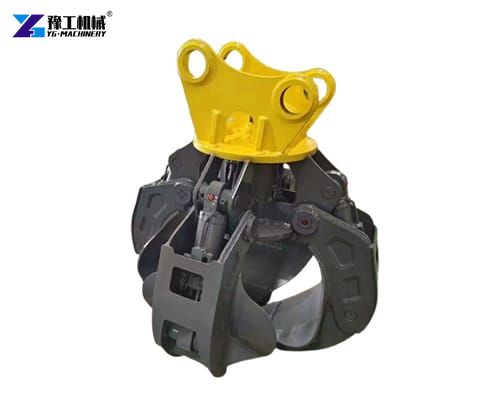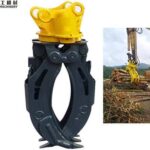Excavator log grapple, often called a logging grapple, forestry grapple, or grapple bucket, is a hydraulically powered attachment mounted to the end of an excavator’s boom. It features two or more robust, curved arms, jaws, or tines that open and close via the excavator’s auxiliary hydraulic circuits. Different from a standard bucket, its primary function is to securely grip, lift, carry, sort, and place bulky, irregular objects like logs, brush, stumps, rocks, and demolition debris.
Benefits of Using Excavator Log Grapple
- Increased Productivity: Handle more material faster than manual labor or less efficient attachments.
- Enhanced Safety: Keep operators away from dangerous manual lifting and handling of heavy logs/debris.
- Reduced Damage: Gentle handling minimizes damage to logs or sensitive ground compared to dragging.
- Improved Sorting & Processing: Easily sort logs by size, stack debris, or feed chippers/grinders.
- Operator Comfort: Ergonomically designed for efficient operation from the cab.
Applications of Log Grapple Attachment
- Forestry and Logging: Loading and unloading logs, tree felling cleanup, and timber yard operations.
- Construction Sites: Moving wooden beams and large branches for site clearance.
- Sawmills and Wood Processing: Feeding logs into saws, sortation, and material management.
- Waste Management: Grabbing tree stumps, branches, and bulky green waste.
How to Select the Right Excavator Log Grapple?
- Size Compatibility: Match the grapple weight to your excavator’s operating capacity.
- Material Type: Opt for reinforced tines for abrasive materials.
- Jaw Capacity: Ensure jaws can handle your largest expected load.
- Hydraulic Flow: Confirm compatibility with your excavator’s hydraulic system.
- Application: Forestry grapples differ from scrap or demolition models—select accordingly.
Maintenance Tips for Longevity
- Regular Inspections: Check for cracks, worn tines, or hydraulic leaks.
- Lubrication: Keep pivot points and hydraulic cylinders well-lubricated.
- Clean After Use: Remove debris to prevent corrosion or jamming.
- Store Properly: Protect from weather when not in use.



